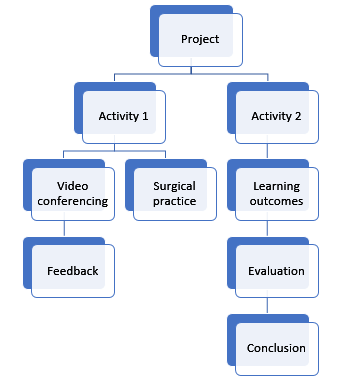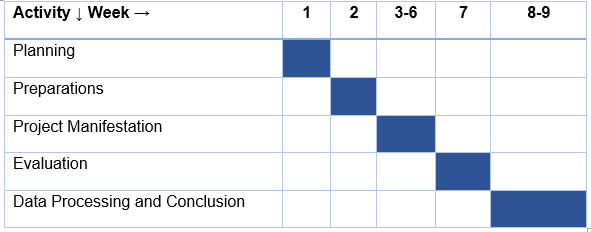Scope Definition
The scope of this project is to elicit successful learning outcomes and certify high-quality skill development among surgeons by means of video conferencing. The core task is to deliver all the necessary knowledge and assess the eminence of this initiative on the basis of certain variables which may or may not include surgeons’ overall satisfaction, video conferencing quality, and other additional factors (Treter, Perrier, Sosa, & Roman, 2013). The team will have to evaluate the costs of the program prior to implementing it. It is also crucial to take into account the implications of the use of video conferencing and track the complications that may transpire during the sessions.
Work Breakdown Structure (WBS)

Risk Management Plan
First, it is rather important to evaluate the risks that may occur during the initiation of the project. These risks may include unstable connection or inability to connect to the translation. During the lifecycle of the project, the project manager will be in charge of identifying and adding the transpiring risks to the management plan. This is necessary because the team will have to take into account the probable impact on the budget or schedule of the project (Chipps, Brysiewicz, & Mars, 2012).
Second, it is critical to assess the prospects of the project and evaluate the probability of occurrence of certain risks. Moreover, the risk management plan should include a measurement scale that would signify the impact of the risks mentioned above on the project. The project manager will have to set priorities on the basis of the identified risks (Hofflander, Nilsson, Eriksén, & Borg, 2013). The last step is to come up with a mitigation strategy so as to be able to effectively eliminate the risks that are inherent in the current project.
Change Management Plan
For this particular project, a change management plan is necessary to track all the modifications that will be made throughout the lifecycle of the project. This document will include all the changes, and every member of the project team will have the possibility to insert the required edits (Gambadauro & Torrejón, 2012). By referring to the change management plan, the team will also be able to coordinate the project and evaluate the correctness of the decisions that are to be made. The current change management plan can also be called a version history due to the detailed description of all the modifications.
Schedule
The project will take approximately nine weeks (see Table 1). During these nine weeks, the project manager expects to reach the pre-set objectives and accomplish the scope of the project. The two most time-consuming phases of the project are the manifestation of video conferencing and interpretation of the results.

Budget
The budget will possibly include only the costs of the equipment that is necessary for the successful planning and inception of the project. This equipment includes personal computers with access to the Internet and video conferencing software. Within the framework of the current project, I would recommend implementing Microsoft Skype for business as the functionalities of this application are free. The only feature that is missing is the possibility to call toll-free numbers, but this does not impact the existing project plan. Also, the budget will not include the costs of the project facility. Therefore, the costs of the project are rather trivial and should not affect the project in any way.
Staffing Plan
There are several critical aspects that define the current staffing plan. First, the project team will not force the medics to participate in the project. Instead, they will be looking for volunteers who are interested in exploring the benefits of video conferencing. The staff will be needed during the course of the project manifestation. This will take approximately three weeks. During these three weeks, the surgeons that volunteered to take part in the project will spend two hours being involved in video conferencing. This project requires that the staff is knowledgeable in terms of operating the PC and using Skype. Nevertheless, the person will not be eliminated if they are not proficient enough (Lynch & Roecker, 2007, p. 50). Overall, the project will involve a number of professional surgeons that are willing to engage in video conferencing.
Communication Management Plan
The project manager expects to communicate the scope of the project to the participants and provide a detailed description of the required tasks. This information will be communicated during a formal meeting which will involve all the members of the project team (Lynch & Roecker, 2007, p. 41). After the project is initiated, the project team will communicate daily with the surgeons that are exposed to video conferencing experience.
All the information concerning the project will be communicated by one of the members of the team who will be responsible for the communication with the partakers (Kemppainen, Kim-Godwin, Mechling, Kanematsu, & Kikuchi, 2012). Every stakeholder will have to communicate in a comprehensible manner so that all the requirements of the initial project are met. The project team will also be responsible for the mitigation of any conflicts that may transpire during the lifecycle of the project.
Procurement Plan
There are no visible implications that may influence the procurement plan. This supposition is based on the fact that all the resources required for this project can be obtained for free. Regardless, there may be a situation in which there will be an insufficient number of personal computers (Lynch & Roecker, 2007, p. 51). In this case, the project manager recommends purchasing the missing hardware from a reliable seller online. Regardless, the surgeons may be divided into teams in order to mitigate the lack of physical resources.
Evaluation Plan
The success of the current project will be evaluated on the basis of a number of factors. First, the project manager is interested in assessing the overall quality of video conferencing process. In order to do so, they will conduct a survey with the intention of gathering the feedback from the participants of the study. Second, the project manager will be interested in tracking the quality of the calls and reliability of the software (Pirkey, Levey, Newberry, Guthman, & Hansen, 2012).
Therefore, they will collect their own data regarding this aspect of the project and then compare it to the participants’ feedback. The outcome that interests the project manager is the efficiency of video conferencing as of a means of a learning environment (Pirkey et al., 2012). The researcher expects to evaluate the obtained knowledge after the project is completed and make reasonable conclusions regarding the need to conduct video conferencing learning and similar activities that involve video conferencing.
References
Chipps, J., Brysiewicz, P., & Mars, M. (2012). A systematic review of the effectiveness of videoconference-based tele-education for medical and nursing education. Worldviews on Evidence-Based Nursing, 9(2), 78-87.
Gambadauro, P., & Torrejón, R. (2012). The “tele” factor in surgery today and tomorrow: implications for surgical training and education. Surgery Today, 43(2), 115-122.
Hofflander, M., Nilsson, L., Eriksén, S., & Borg, C. (2013). Discharge planning: Narrated by nursing staff in primary healthcare and their concerns about using video conferencing in the planning session – An interview study. Journal of Nursing Education and Practice, 3(1), 4-31.
Kemppainen, J. K., Kim-Godwin, Y. S., Mechling, B., Kanematsu, Y., & Kikuchi, K. (2012). Promoting cultural awareness in nursing education through international videoconferences. International Journal of Nursing Practice, 18(3), 56-61.
Lynch, M., & Roecker, J. (2007). Project managing e-learning: A handbook for successful design, delivery and management. London, UK: Routledge.
Pirkey, J. M., Levey, J. A., Newberry, S. M., Guthman, P. L., & Hansen, J. M. (2012). Videoconferencing expands nursing students’ cultural realm. Journal of Nursing Education, 51(10), 586-590.
Treter, S., Perrier, N., Sosa, J. A., & Roman, S. (2013). Telementoring: A multi-institutional experience with the introduction of a novel surgical approach for adrenalectomy. Annals of Surgical Oncology, 20(8), 2754-2758.
